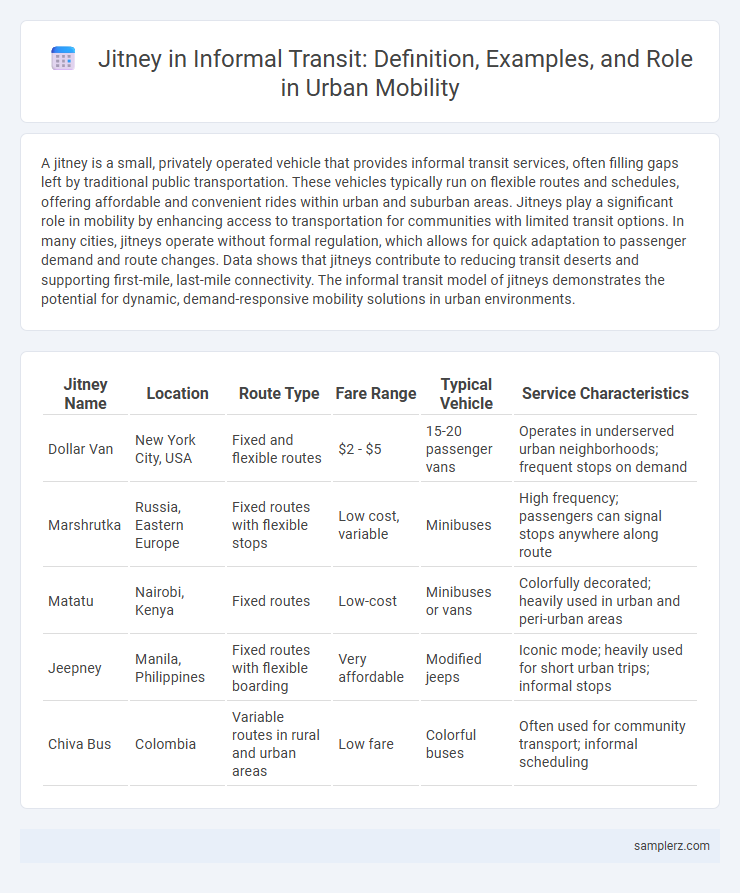A jitney is a small, privately operated vehicle that provides informal transit services, often filling gaps left by traditional public transportation. These vehicles typically run on flexible routes and schedules, offering affordable and convenient rides within urban and suburban areas. Jitneys play a significant role in mobility by enhancing access to transportation for communities with limited transit options. In many cities, jitneys operate without formal regulation, which allows for quick adaptation to passenger demand and route changes. Data shows that jitneys contribute to reducing transit deserts and supporting first-mile, last-mile connectivity. The informal transit model of jitneys demonstrates the potential for dynamic, demand-responsive mobility solutions in urban environments.
Table of Comparison
| Jitney Name | Location | Route Type | Fare Range | Typical Vehicle | Service Characteristics |
|---|---|---|---|---|---|
| Dollar Van | New York City, USA | Fixed and flexible routes | $2 - $5 | 15-20 passenger vans | Operates in underserved urban neighborhoods; frequent stops on demand |
| Marshrutka | Russia, Eastern Europe | Fixed routes with flexible stops | Low cost, variable | Minibuses | High frequency; passengers can signal stops anywhere along route |
| Matatu | Nairobi, Kenya | Fixed routes | Low-cost | Minibuses or vans | Colorfully decorated; heavily used in urban and peri-urban areas |
| Jeepney | Manila, Philippines | Fixed routes with flexible boarding | Very affordable | Modified jeeps | Iconic mode; heavily used for short urban trips; informal stops |
| Chiva Bus | Colombia | Variable routes in rural and urban areas | Low fare | Colorful buses | Often used for community transport; informal scheduling |
Introduction to Jitney Services in Informal Transit
Jitney services operate as small, flexible vehicles providing informal transit options primarily in urban and suburban areas where traditional public transportation is limited. These services often utilize vans or minibuses that follow semi-fixed routes with flexible stops, catering to passengers seeking affordable and convenient travel. Jitneys contribute significantly to last-mile connectivity and serve as a vital alternative in transportation systems with unmet demand.
Historical Evolution of Jitneys in Urban Mobility
Jitneys emerged in the early 20th century as privately operated, small-capacity vehicles providing flexible, affordable transit options in urban areas, filling gaps left by fixed-route streetcars and buses. Their informal operation fostered rapid adaptation to passenger demand and routes, influencing the development of shared mobility models in cities like Los Angeles and Detroit. Over time, regulatory challenges and competition from formal transit systems shaped the evolution of jitneys, highlighting their role in the broader history of urban mobility innovation.
Characteristics of Jitney Operations in Informal Networks
Jitney operations in informal transit networks are characterized by their flexible routes and schedules, often responding dynamically to passenger demand rather than fixed timetables. These vehicles typically operate with lower fares and minimal regulatory oversight, enabling rapid, community-driven mobility solutions in underserved urban areas. The informal nature of jitneys fosters high frequency and accessibility, but also presents challenges in safety, coordination, and integration with formal transit systems.
Popular Cities with Thriving Jitney Systems
New York City, Miami, and Philadelphia have well-established jitney networks, providing affordable and flexible transit options in densely populated urban areas. These informal transit systems effectively fill service gaps left by conventional public transportation, offering frequent stops and routes tailored to local commuter needs. The popularity of jitneys in these cities highlights their role in reducing traffic congestion and enhancing last-mile connectivity.
Jitney Vehicle Types and Configurations
Jitney vehicle types in informal transit typically include vans, minibuses, and modified passenger cars designed for flexible, short-distance routes. These vehicles often feature seating configurations that balance passenger capacity with standing room, enabling frequent stops along busy urban corridors. Customizable layouts and durable interiors enhance their adaptability to varying passenger volumes and local transit demands.
Jitneys versus Formal Public Transport: Key Differences
Jitneys operate on flexible, demand-responsive routes without fixed schedules, offering rapid and affordable transit options in urban areas underserved by formal public transport systems. Unlike formal buses or trains, jitneys often provide door-to-door or curbside pick-ups, enhancing convenience for commuters seeking personalized travel solutions. The informal nature of jitneys allows for adaptive service patterns but may lack regulatory oversight, safety standards, and consistent fare structures typical of formal transit agencies.
Socio-Economic Impact of Jitneys in Communities
Jitneys enhance mobility in underserved urban neighborhoods by providing affordable, flexible transit options that bridge gaps left by traditional public transportation. Their presence stimulates local economies by increasing access to jobs, education, and services, which can reduce unemployment and improve quality of life. Jitneys also generate informal employment opportunities and promote social inclusion, particularly for low-income and minority communities.
Regulatory Challenges Facing Jitney Operators
Jitney operators face regulatory challenges including inconsistent local licensing requirements that vary widely across municipalities, hindering uniform compliance. Many jurisdictions impose strict safety and insurance mandates that increase operational costs, limiting jitney scalability and service availability. Enforcement gaps and unclear legal status often result in jitney services operating in a legal gray area, complicating efforts to integrate them into formal transit systems.
Technological Innovations in Jitney Services
Technological innovations in jitney services include GPS tracking systems that enhance route optimization and real-time passenger information, improving overall service efficiency. Mobile payment platforms and app-based booking systems facilitate seamless rider experiences and increase accessibility. Data analytics tools help operators adjust routes and schedules dynamically to meet fluctuating demand patterns in informal transit networks.
Future Prospects for Jitney Integration in Urban Mobility
Jitneys are poised to play a transformative role in urban mobility by offering flexible, demand-responsive transit options that complement existing public transportation systems. Integration of jitney services with smart city infrastructure and real-time data analytics can enhance route optimization, reduce congestion, and improve last-mile connectivity. Advances in electric and autonomous vehicle technology further position jitneys as sustainable and efficient solutions for addressing the growing urban transportation challenges.

example of jitney in informal transit Infographic
 samplerz.com
samplerz.com